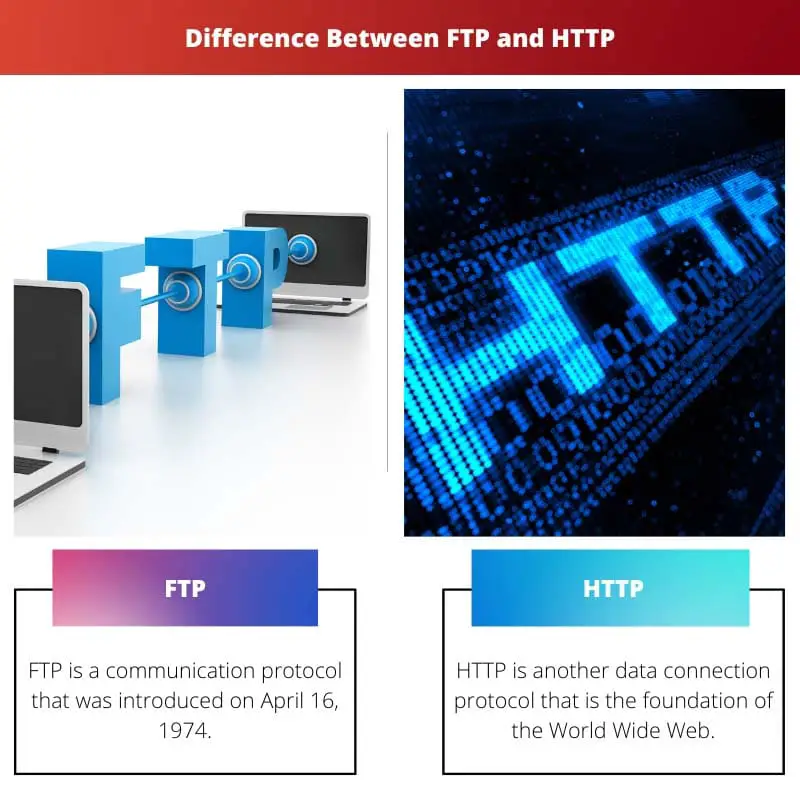The internet stores a huge amount of files and data on clouds, which is a term referring to huge servers.
To exchange these files and data between a client and a server, transfer protocols such as the File Transfer Protocol and the HyperText Transfer Protocol are used.
Key Takeaways
- FTP is used for file transfer, while HTTP is used for web page access.
- FTP is less secure than HTTP.
- FTP requires a separate connection for every file transfer, while HTTP can transfer multiple files through a single connection.
FTP vs HTTP
FTP is a network protocol including a set of rules that allow the process of uploading and downloading files from one location to another on the internet or computer systems. HTTP is an application layer protocol that enables transferring various web pages over various computers present on the internet.

FTP is a communication protocol that was introduced on April 16, 1974. It uses separate data and control connections to transfer files between servers and clients.
The use of FTP requires authentication and it is quite slow. While a request is in process, the data connection is active and the control connection is inactive.
HTTP is another data connection protocol that is the foundation of the World Wide Web. It makes the requests for data over the internet easier and most of the web pages on the internet use the HTTP protocol.
HTTP was introduced in January 1997 and it eliminated a lot of the shortcomings of FTP, becoming severely popular in the internet era.
Comparison Table
| Parameters of Comparison | FTP | HTTP |
|---|---|---|
| Abbreviation | It stands for File Transfer Protocol. | It stands for Hypertext Transfer Protocol. |
| Function | It is the mechanism through which files are downloaded and uploaded through the internet. | It facilitates the transmission of web pages between different computers. |
| Number of Connections | It works on two connections, data and control. | It only supports one connection, the data connection. |
| Speed | It is much slower and time-consuming. | It is very fast and efficient. |
| Type of Transfer | It uses an out-of-band type of transfer. | It uses an in-band type of connection. |
What is FTP?
FTP or File Transfer Protocol is a communication system for the purpose of transferring files on the internet in a client-server model. It requires authentication for its use but it was developed at a time when security breaches were not a big issue.
It functions on TCP ports 20 and 21. The FTP protocol is meant for transferring large files for which it is very efficient. The files transferred using this protocol are saved to memory.
The FTP is slower as compared to newer and more modern protocols that are faster and more efficiently designed for the purpose of transferring files and web page data in a more efficient way.
The most prominent browsers such as Mozilla Firefox, Internet Explorer, and Google Chrome have entirely stopped supporting FTP.
The control connection in FTP is of a persistent nature whereas the data connection it uses is of a non-persistent nature. The FTP also maintains states, meaning the data from previous sessions are retained by the server in its memory.
It runs on either active or passive mode depending on the type of data connection used. Download managers are able to establish connections with FTP servers and exchange files.
Abhay Bhushan, an Indian computer scientist, wrote the code for FTP as a student, over fifty years ago. He also made big contributions to the email system.
What is HTTP?
HyperText Transfer Protocol is a communication protocol that is used to transmit web pages over the internet. It is the most used protocol on the internet right now as evident in most website URLs that begin with HTTPS.
It is, therefore, the most developed and advanced communication system for the internet.
HTTP use transmission protocol TCP 80. The files transferred using HTTP are not saved in memory and this protocol is very efficient and fast in transferring small files.
It is open to everyone without any barriers to authentication and requirements. The latest version of HTTP called RFC 8740 came out in 2020.
HTTP can use both types of connections, persistent and non-persistent. The HTTP also controls the mannerisms in which a web browser will respond when a web page using the HTTP protocol is invoked.
Sessions using the HTTP are stateless. The World Wide Web Consortium (W3C) also has a major hand in the development of HTTP.
The chain of events in an HTTP request is that first, a browser sends an HTTP request to the server which is then accepted and executed by the server which then sends the HTTP response to the browser which is displayed to the user.

Main Differences Between FTP and HTTP
- The FTP communication method maintains states whereas the HTTP is stateless, meaning session states from previous are not preserved.
- HTTP was released almost 20 years after FTP and is the most dominant internet communication technique whereas FTP has been done away with.
- FTP uses a two-way connection method whereas HTTP is based on a one-way communication pathway, meaning it is faster and more secure.
- HTTP employs TCP port number 80 whereas FTP used TCP port numbers 20 and 21.
- HTTP’s primary use is in accessing websites and text information on the internet whereas FTP is used to access big files, applications, and media from servers.
